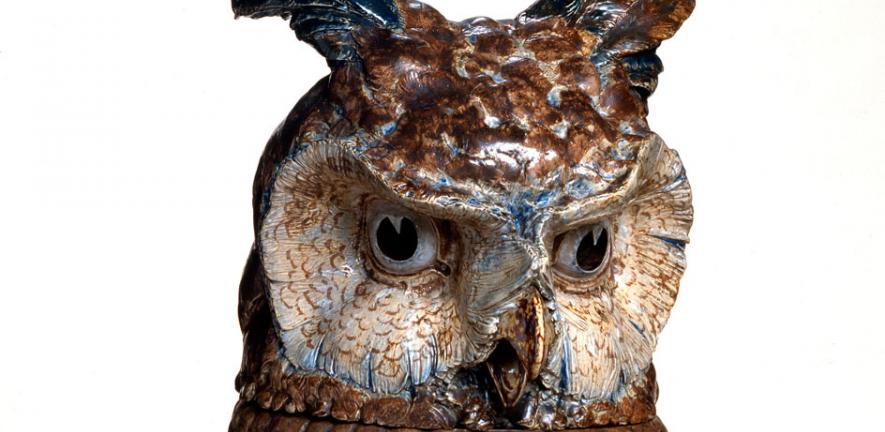
He had a lively imagination which gave rise to a procession of grotesque and humorous creatures masquerading as jugs, spoon warmers and toast-racks.
He had a lively imagination which gave rise to a procession of grotesque and humorous creatures masquerading as jugs, spoon warmers and toast-racks.
What is it?
This curious looking object is a gigantic punch bowl in the shape of an owl. It has a removable head, fashioned in salt-glazed stoneware and decorated with blue, brown, and sage-green slips. The owl was made by the Martin brothers, Robert Wallace, Walter and Edwin in 1903, who are sited as the first British studio potters.
Wallace Martin, who had trained as a sculptor, concentrated on modelling. He had a lively imagination which gave rise to a procession of grotesque and humorous creatures masquerading as jugs, spoon warmers and toast-racks. His bird jars, known as `Wally Birds', are vaguely rook-like and have curiously human expressions. His owls are truer to nature, and were probably inspired by earlier slipware and salt-glazed stoneware owls. Most of these birds are 20-35 cm high, but Martin also made a few giant owls, of which this example measuring 103cm is the largest known.
What’s the story?
In 1893 Wallace Martin famously made a punch bowl `in the shape of a monster owl' for The Bohemian Club of San Francisco, a literary club founded in 1872, which has an owl as its emblem. According to the ceramic historian Blacker, Wallace's first model developed a firing crack and was not despatched, but another arrived safely only to be destroyed in the 1906 earthquake.
On Wallace Martin’s death the Fitzwilliam owl was purchased by Cyril Andrade on behalf of Dr James Glaisher, at a Sotheby’s sale of Wallace Martin’s pottery on 24 October 1924, for £25. Dr Glaisher DSc, FRS was an eminent mathematician, astronomer, Fellow of Trinity College, Cambridge and collector of pottery. On his death in 1928, Glaisher’s collection, of almost 6,000 pieces of predominantly European pottery and porcelain, was bequeathed to the University of Cambridge for the Fitzwilliam Museum, together with £10,000 for its care. Dr Glaisher viewed the punch bowl as one of the star items in his collection.
Can we see it?
The Punchbowl is on display in the Glaisher Gallery at the Fitzwilliam Museum.
Want to know more?
Read Julia E. Poole’s English Pottery (Fitzwilliam Museum Handbook)
This work is licensed under a Creative Commons Licence. If you use this content on your site please link back to this page.

